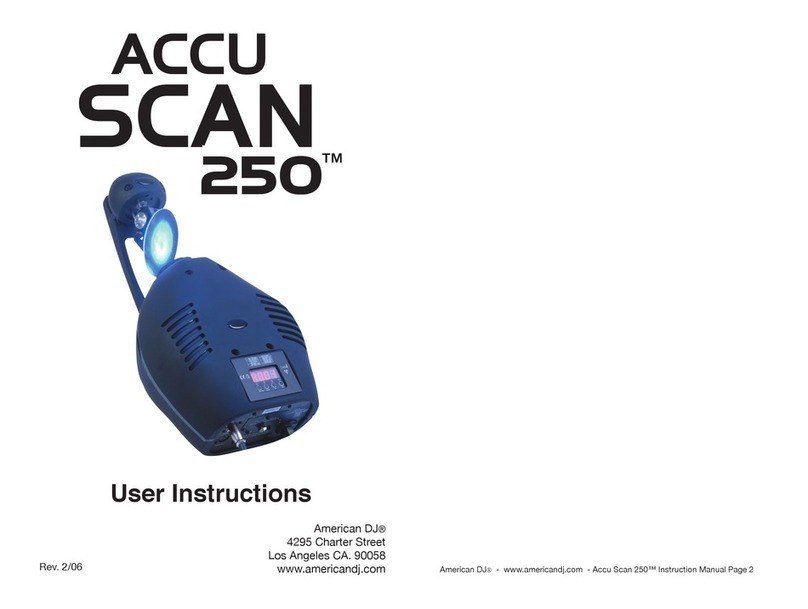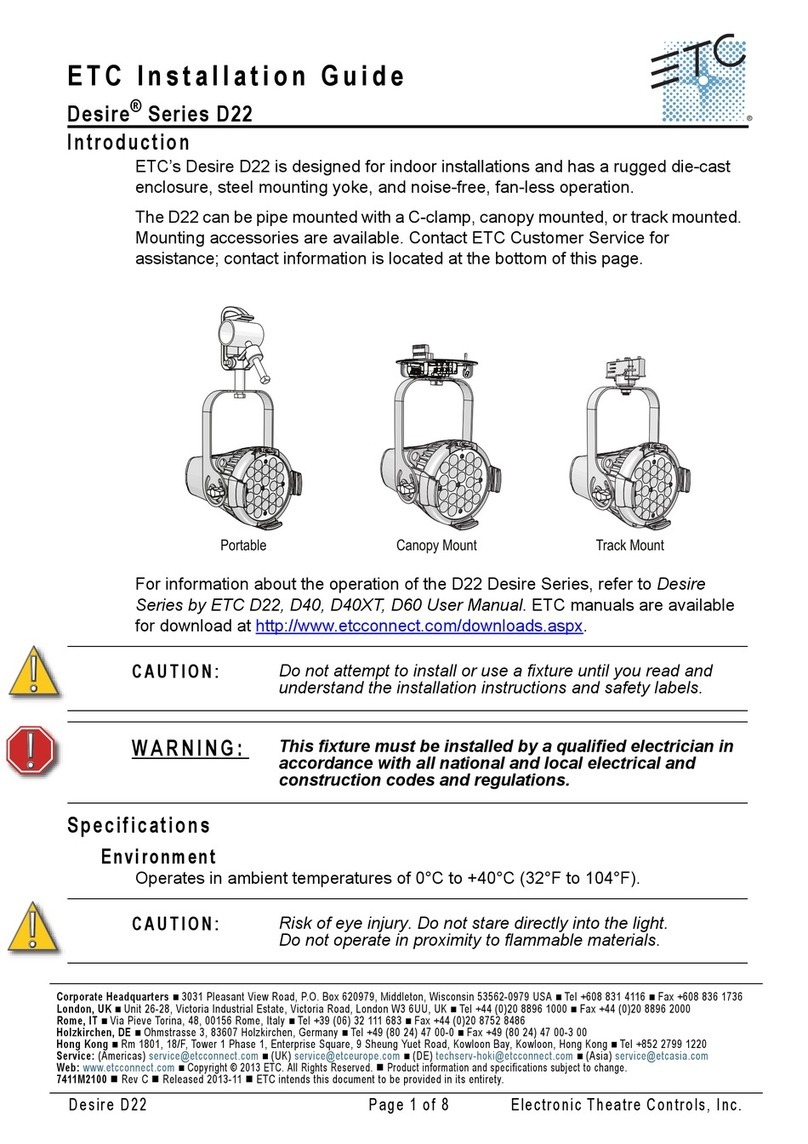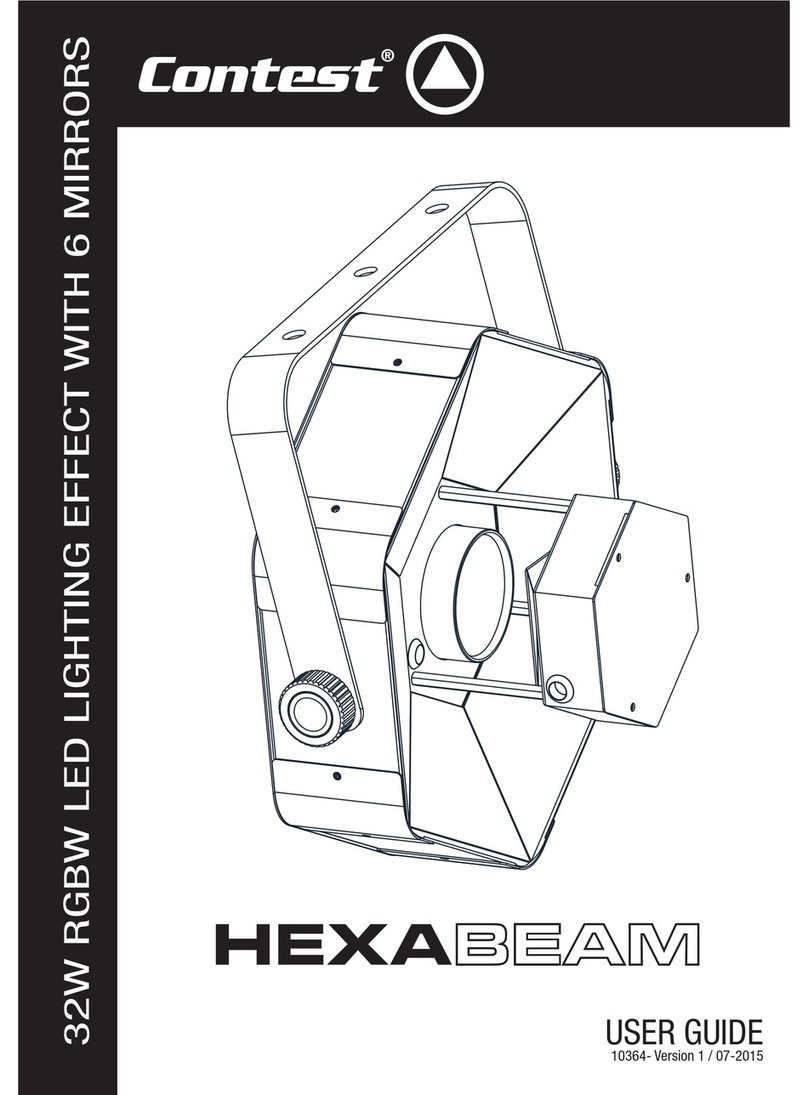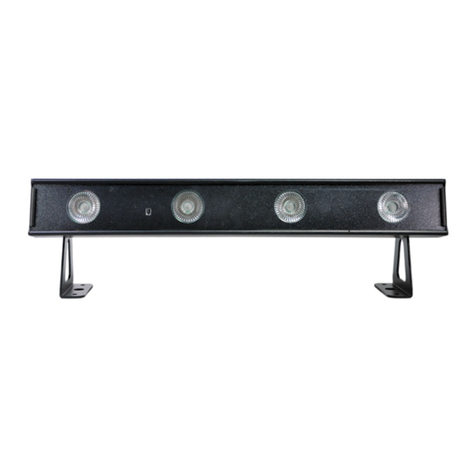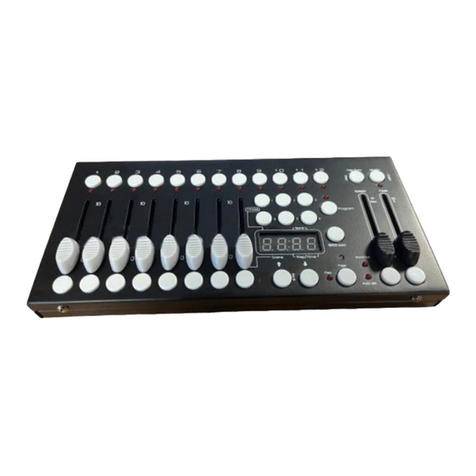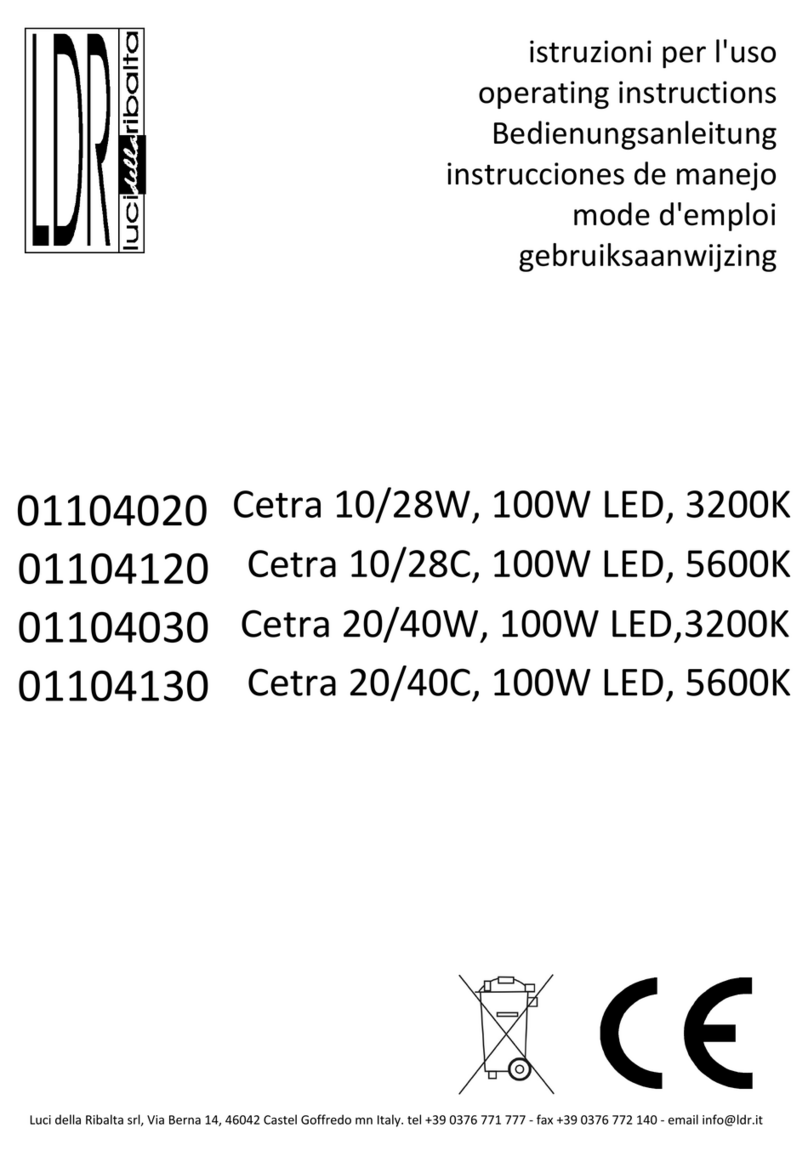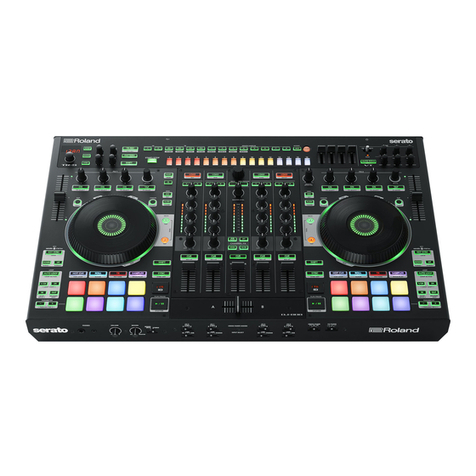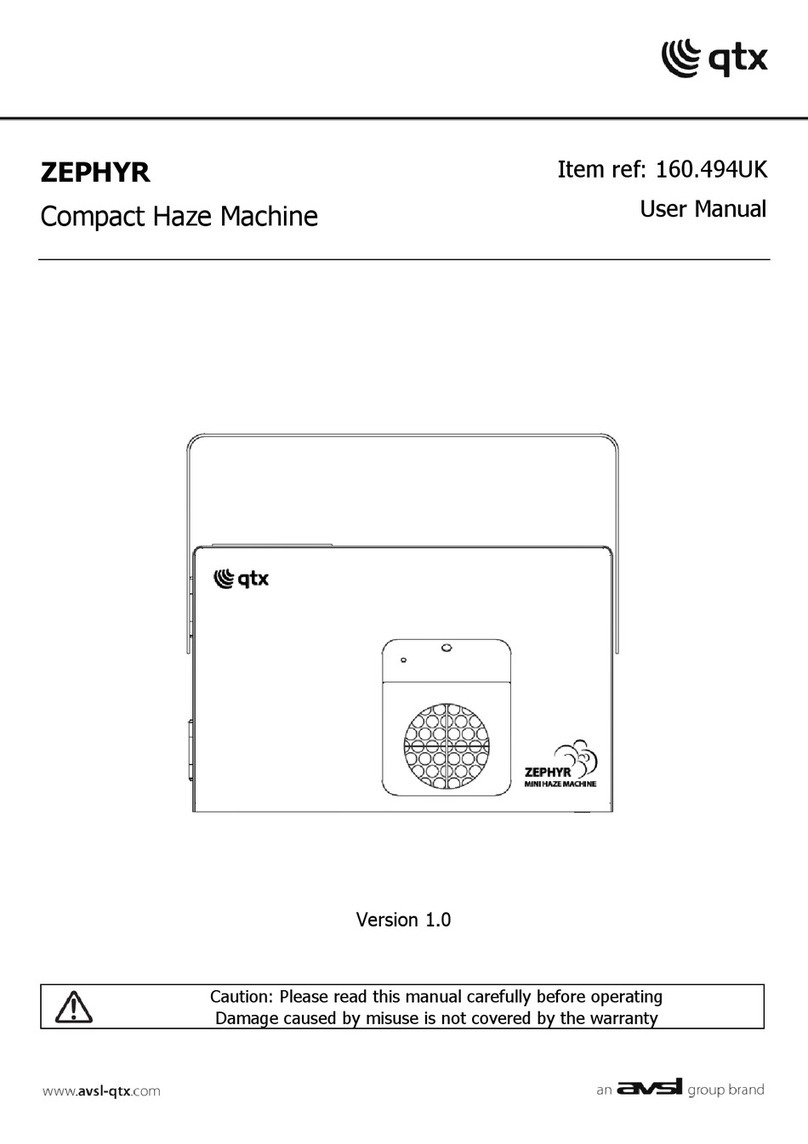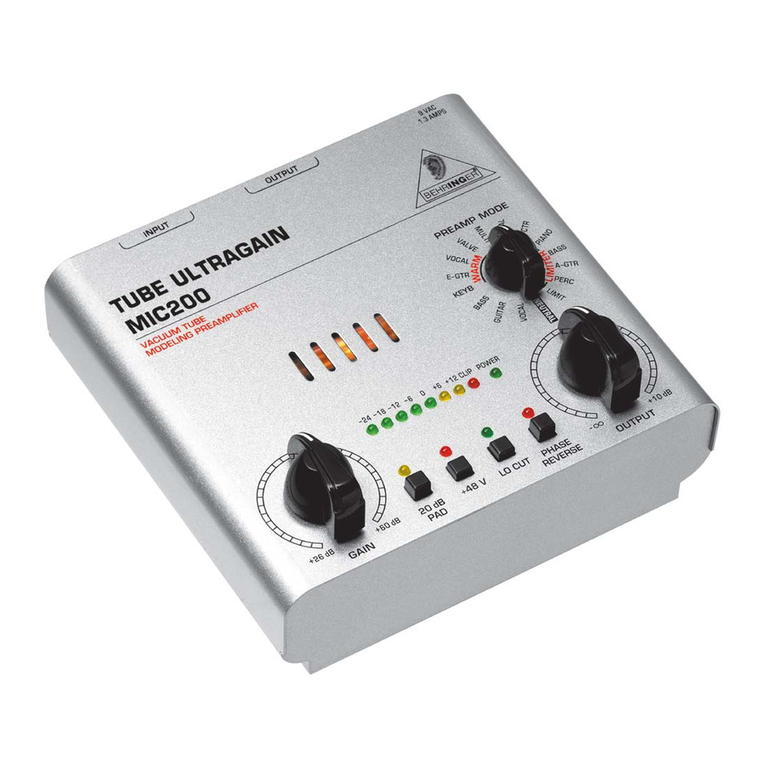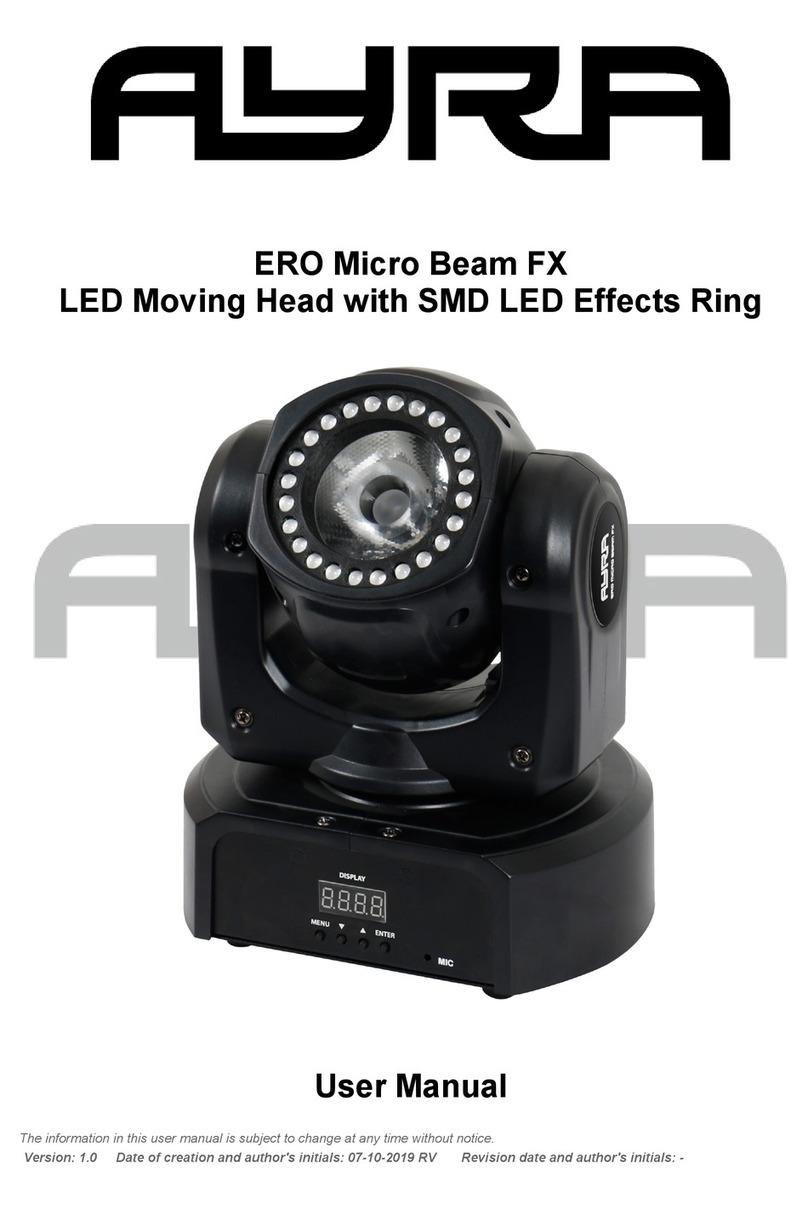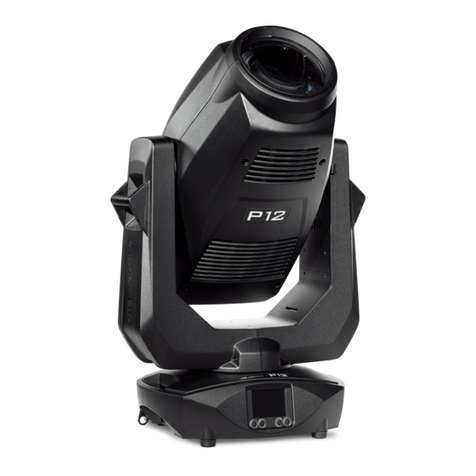Speck via Fader VF10 User manual

via Fader
Outboard Fader Channels
Reference Manual
Models VF10 and VF16
speck electronics


Speck Electronics products are warranted to the original owner to be free of
defects in material or workmanship.
This warranty does not apply to any product subject to accident, misuse,
neglect, or failure to comply with normal maintenance procedures, or if the
serial number has been defaced, altered, or removed; nor will Speck
Electronics accept responsibility for damages resulting from improper
installation, alteration or unauthorized parts or repairs. If the product is
modified by the customer without permission, the customer agrees to pay for
parts and labor necessary to remove the modification before repair. The cause
of the defect is in the sole judgment of Speck Electronics.
Should a defect develop within one year of purchase from Speck Electronics
or an authorized dealer, Speck Electronics will supply the part or parts
necessary at no charge. Labor is covered in this warranty for a period of one
year. Outside service, repairs, or pickups are not covered under this warranty.
Any item returned for warranty repair should be sent, if possible, in the
original packing container, prepaid to Speck Electronics, 341 E. Alvarado
Street, Fallbrook, California, 92028. If, in our opinion, the packing container
is improper for return shipping, we reserve the right to supply a new container
at a minimal charge.
In the interest of improving Speck products, designs and specifications are
subject to change without notice. It should be mentioned that if a change is
necessary for any reason, we make every effort to document
that change and send an "update notice" to all customers at no charge.
Speck Electronics makes no warranty of any kind with regard to this material,
including, but not limited to, the implied warranties of merchantability and
fitness for a particular purpose. Speck Electronics shall not be liable for
errors contained herein or for incidental consequential damages in connection
with the furnishing, performance, or use of this material.
This document contains proprietary information which is protected by
copyright. All rights are reserved. No part of this document may be
photocopied, reproduced, or translated into another language without the prior
written consent of Speck Electronics.
The information contained in this document is subject to change without
notice.
All trademarks are the property of their respective owners.
Speck Electronics
341 East Alvarado Street
Fallbrook, California 92028
USA
1+760-723-4281
www.speck.com
Warranty
Notice
ii

General Description ............................................................
Standard Accessories ..........................................................
General ...............................................................................
Unpacking and Inspection ..................................................
Cleaning .............................................................................
Mechanical Installation ......................................................
Power Module Installation .................................................
Power Module Mounting Location ....................................
Physical Placement of Adjacent Equipment ......................
Hooking up the via Fader ...................................................
Overview ............................................................................
Signal Flow Diagram - VF10 .............................................
Signal Flow Diagram - VF16 .............................................
Front Panel Controls ........................................................
Channel Fader ...............................................................
Power LED....................................................................
Rear Panel .........................................................................
Fader Line Inputs ..........................................................
Fader Line Outputs........................................................
Power Inlet ...................................................................
Gain Select ...................................................................
Specifications ...........................................................
1
2
3
3
3
3
4
5
5
6
7
8
9
10
10
11
11
11
11
12
12
13
Contents
iii
Chapter 1 Introduction
Chapter 2 Installation
Chapter 3 Operation

Introduction
Chapter 1 Introduction Section 111
Thank you for purchasing our via Fader Outboard Fader Channels. The via Fader (V.F.) has operational
features that are easy to understand and you should be up and running in no time. If you are unfamiliar
with audio equipment or audio signal flow, it is recommended that you read this manual. If you have any
questions regarding the V.F. or any Speck product, do not hesitate to contact Speck Electronics.
Speck Electronics
341 E. Alvarado Street
Fallbrook, CA 92028
Phone: +760-723-4281
Email: [email protected]
www.speck.com
General Description
The via Fader is available in 4 models:
VF10 - 10 Outboard Fader Channels
VF16 - 16 Outboard Fader Channels
VF10M - 10 Channel Outboard Fader System with mix assign and master outputs
VF16M - 16 Channel Outboard Fader System with mix assign and master outputs.
Model VF10 Model VF16
Model VF10M Model VF16M

Chapter 1 Introduction Section 2
This manual has been prepared for the VF10 and VF16. Unless otherwise noted, all references in
this manual will be for the via Fader Model VF10. There is no operational difference between the
two models except for the number of fader channels.
The via Fader (V.F.) is an outboard fader channel available with 10 or 16 slide fader channels. No
VCA’s, no CMOS switching, and no A/D - D/A converters... just 100% analog signal path.
Each fader channel has the necessary input and output electronics to allow the V.F. to interface to any
balanced, unbalanced, transformer, or transformer-less line level signal. But most importantly... no
additional mixer or audio interface is required. The V.F. has high headroom that will handle balanced
signals up to +28dBu. All audio inputs and outputs are fully balanced and available on DB-25
connectors.
With its clean, uncluttered layout, the V.F. can be placed in a convenient desktop location or installed
in your 19" rack.
Standard Accessories
· PS4-V Power Module
PS4-V-NA for 100 and 120VAC Mains
-or-
PS4-V-EU for 220, 230, and 240VAC Mains
· Operations Manual

General
The following information should give you the basics on how to install the via Fader (V.F.) and power
module. The proper installation of the V.F. requires a clear understanding of audio wiring, AC
distribution, grounding, and shielding techniques.
If the V.F. is being installed into a larger studio or as an expander to a host console, it may be
necessary to retain the services of someone experienced in these matters.
Unpacking & Inspection
The V.F. is delivered in a special protective container and was carefully inspected both mechanically
and electrically before shipment. All items should be physically free of mars and scratches and in
perfect electrical order upon receipt. To confirm this, the mixer and power supply should be inspected
for physical damage that may have occurred in transit. Any damage should be reported to your dealer
or delivery company as soon as possible.
If the product is to be shipped to Speck Electronics for service or repair contact Speck Electronics for
a Return Merchandise Authorization (RMA). Include the model number and serial number of the
product. Place the product in the original container if available. If the original container is not used,
wrap the product in heavy plastic before placing in an inner container. Use plenty of packing material
around all sides of the product and protect panel faces with cardboard strips. Mark shipping container
with "Delicate Instrument" or "Fragile", and insure the shipment for the proper amount.
Cleaning
To clean the front panel, wipe the surface gently using a soft lint-free cloth to avoid scratching the
panel or markings. Paper towels are not recommended. Commercially available window cleaner
solutions may be used; however, the solution should be applied to the cloth and not the panel to avoid
the seepage of liquid to the inside of the enclosure.
Do not use brushes or feather dusters to remove dust. This may cause dust to fall into the openings
around the slide fader and pushbutton switches.
Mechanical Installation
The via Fader was designed to be placed on a desktop or installed in a 19" rack. The location of the
via Fader should be such that the operator has a clear, unobstructed view of the front panel from
his/her normal operating position. The unit should also be within easy reach of the operators’ normal
position in order to facilitate the use of the front panel controls.
Installation
Chapter 2 Installation Section 3

Power Module Installation
The V.F. is shipped with an external 16 VAC power module. The power module has a 6' cable and is
fitted with a special 10 pin connector for mating to the "Power Input” on the rear of the V.F. All AC
rectification, filtering, and DC regulation is performed within the chassis of the V.F.
The PS4-V power module is available in 2 versions; a North American version and European version.
The North American version (PS4-V-NA) is designed to operate with 100 or 120 VAC power and the
European version (PS4-V-EU) is designed to operate with 220, 230 or 240 VAC power.
Use only the PS4-V external power module that is supplied with your V.F. mixer. Using any
other power module or power source will most definitely damage the V.F.
To connect the power module to the V.F., fit the 10 pin rectangular connector to the chassis mount
receptacle on the bottom of the V.F. The respective connectors are keyed so the plug and the receptacle
can fit in only one direction. Before connecting the 10 pin rectangular plug to the V.F., make certain
the power module is not connected to an AC receptacle.
The PS4-V power module has an internal "one shot" thermal fuse. Fuse replacement is not possible
with this module. If it has been determined that the power module has failed, contact Speck
Electronics for a factory replacement at +760-723-4281.
The power module is a "Class 2 transformer" device and can only be used indoors. The V.F. and
power module should never be exposed to rain or moisture.
Because the power module uses a 2 bladed AC plug, audio signal grounds and DC common at
the V.F. are isolated from the AC safety earth. The chassis of the V.F. can be connected to earth
by way of the chassis ground terminal on the rear panel.
Chapter 2 Installation Section 4
PS4-V-NA PS4-V-EU

Power Module Mounting location
One of the primary reasons that the PS4-V power module is external is to insure that its power transformer
maintains a safe distance from the active electronics of the V.F. It is recommended that the power module be
located at a reasonable distance from the V.F. and audio cables. For that matter, any device that has a strong
magnetic power field should be kept at a reasonable distance from the V.F. and its audio cables.
The external power module does not provide an AC power switch. It is recommended the power module be
plugged into an AC power strip that uses a power switch.
Physical Placement of Adjacent Equipment
Any device that emits a high EMI (Electro Magnetic Interference) or RFI (Radio Frequency Interference)
energy field should be treated with suspicion. EMI is considered any unwanted signal which adversely affects
the operation of the via Fader or the mixing system.
Electronic equipment such as power amplifiers, power supplies (especially wall mount type), video monitors,
computers, certain synths and samplers must be located away from the V.F. and its associated cables. It may be
necessary to alter the positions of certain equipment that you feel would cause buzzes or hums in the mixer
system.
Chapter 2 Installation Section 5

Hooking up the via Fader
The via Fader will require a minimum of two (2) DB-25 harnesses to operate; one (1) for the inputs
and one (1) for the outputs. A complete system will require a maximum of four (4) DB-25 harnesses
and various 1/4” TRS cables.
The rear panel connectors of the Model VF10 differ slightly from the VF16 in that the VF10 includes
balanced 1/4” TRS jacks for inputs and outputs 9 and 10. These jacks are wired in parallel with the
DB-25 connectors and can be used if you chose not to use DB-25 harnesses for the connections 9-10.
Due to the high performance of the V.F. it is recommended that you use only the highest quality audio
cable. A high quality cable by definition is a cable that provides good mechanical strength, high
microphonic noise immunity, high frequency response, low crosstalk, and 100% shielding ability. All
audio cable used with the V.F. should be a 3 conductor foil shield type (2 inner conductors and a
shield drain conductor). It is not recommended that the 2 conductor "off the shelf cables" be used.
All wire and cable interfaced to the V.F. should be terminated with high quality connectors. A ¼" plug
or XL connector should make a positive connection to its respective mating jack and provide adequate
strain relief to its cable. All connectors should also have a metal shell to provide 100% shield for
exposed conductors.
We do believe that “you get what you pay for” and advise not to purchase lower quality cables. We
recommend that you purchase from a reputable cable manufacturer that uses brand name materials.
Brand name cables include (in no particular order) Mogami, Canare, Belden, Gepco, Redco, and
ProCo. Connector brands include Switchcraft and Neutrik.
When the time comes to actually interconnect your equipment, proceed slowly. Interfacing the many
pieces of electronic equipment to your via Fader and audio system should be a logical and methodical
process. Start by connecting one line signal at a time; carefully listening and monitoring your
progress. If a problem arises, such as a buzz, hum, intermittent signal, or nonexistent signal, stop at
that point and solve the problem before proceeding.
Care should be taken to support the DB-25 audio harnesses as not put stress on the chassis
mounted DB-25 connectors.
Chapter 2 Installation Section 6
BALANCED INPUTS 1-8 BALANCED INPUTS 9-16 BALANCED OUTPUTS 1-8 BALANCED OUTPUTS 9-16
BALANCED INPUTS 1-8 BALANCED INPUTS 9-10 BALANCED OUTPUTS 1-8 BALANCED OUTPUTS 9-10
Model VF16
Model VF10
OUTPUTSINPUTS
9 10 9 10
Not Used
Not Used

Overview
In this section we hope to give you basic information on the operation of the via Fader (V.F.) and
adequately describe its controls and connectors.
The information in this section of the manual is intended to help with the technical process when
using your V.F. Words alone could not adequately describe how to adjust the controls for every
situation you might encounter with the V.F. You should experiment with fader levels to achieve the
best results for any particular situation. Your ears should be your best gauge of how to adjust the
faders on the V.F. to make the sound fit your requirements.
Operation
Chapter 3 Operation Section 7
Model VF10 Top
Model VF10 Rear

Typical of channels 1-8
0
0
8
1
FADER
BALANCED
INPUTS 1-8 BALANCED
OUTPUTS 1-8
FADER GAIN
10dB
UNITY
SELECT
Typical of channels 9-10
0
0
8
1
FADER
BALANCED
INPUTS 9-10 BALANCED
OUTPUTS 9-10
FADER GAIN
10dB
UNITY
SELECT
BALANCED
INPUTS 9-10 BALANCED
OUTPUTS 9-10
Signal Flow Diagram For Model VF10
Use this channel signal flow diagram shown below as a reference when reading the descriptions of the
controls and connectors [1] through [8] in this chapter.
Figure 1. via Fader VF10 signal flow and reference designations.
Chapter 3 Operation Section 8
1
1
3
3
5
5
8
46
8

Figure 2. via Fader VF16 signal flow and reference designations.
Signal Flow Diagram For Model VF16
Use this channel signal flow diagram shown below as a reference when reading the descriptions of the
controls and connectors [1] through [8] in this chapter.
Chapter 3 Operation Section 9
Typical of channels 1-8
0
0
8
1
FADER
BALANCED
INPUTS 1-8 BALANCED
OUTPUTS 1-8
FADER GAIN
10dB
UNITY
SELECT
Typical of channels 9-16
0
0
8
1
FADER
BALANCED
INPUTS 9-16 BALANCED
OUTPUTS 9-16
FADER GAIN
10dB
UNITY
SELECT
1
1
3
3
5
5
8
8

1. Channel Fader
This 100mm slide fader adjusts the level of its respective
channel and has a range of ∞dB to 10dB. The operation of
the slide fader adjusts the level to the fader line output.
The “0” mark is the "unity gain" setting for the fader
channel.
Fader In to Fader Out Gain
With a balanced +4dBu signal present at a DB-25 line
input and its respective fader set to the “0” mark, the
corresponding balanced DB-25 line output will be +4dBu.
With the Gain Select [8] set for 10dB and the slide fader set
at the “10” mark this will give the channel a total of 20dB of
gain.
2. Power LED
This LED will illuminate orange when the power is applied
to the via Fader.
FRONT PANEL
Chapter 3 Operation Section 10
1
2

Channel High Low Gnd
124
12
25
210
23
11
321
9
22
47
20
8
518
6
19
64
17
5
715
3
16
81
14
2
Figure 3
Not Used 87654321
The DB-25 connectors conform
to the Tascam standard pin layout
3. DB-25 Line inputs
There are two DB-25 connectors for the fader line
inputs. These balanced inputs will accept a +4dBu
reference signal.
On the VF10 the two DB-25 connectors are inputs
1-8 and 9 and 10. Inputs 11-16 not used on the
Model VF10.
On the VF16 the two DB-25 connectors are inputs
1-8 and 9-16.
4. 1/4” TRS Line inputs (VF10 only)
The DB-25 fader inputs 9 and 10 are duplicated
on the Model VF10 with 1/4” TRS balanced jacks.
These inputs are internally wired in parallel and
identical in every aspect except for the connector.
The 1/4” TRS and DB-25 inputs should not be
used at the same time.
5. DB-25 Line outputs
There are two DB-25 connectors for the fader line outputs. With a balanced +4dBu signal present at
the DB-25 line input and the slide fader set to the “0” mark, the balanced DB-25 line output will be
+4dBu.
On the VF10 the two DB-25 connectors are outputs 1-8 and 9 and 10. Outputs 11-16 not used on the
Model VF10.
On the VF16 the two DB-25 connectors are outputs 1-8 and 9-16.
6. 1/4” TRS Line outputs (VF10 only)
The DB-25 fader outputs 9 and 10 are duplicated on the Model VF10
with 1/4” TRS balanced jacks. These outputs are internally wired in
parallel and identical in every aspect except for the connector.
The 1/4” TRS and DB-25 may be used at the same time.
Chapter 3 Operation Section 11
BALANCED INPUTS 1-8 BALANCED INPUTS 9-16 BALANCED OUTPUTS 1-8 BALANCED OUTPUTS 9-16
BALANCED INPUTS 1-8 BALANCED INPUTS 9-10 BALANCED OUTPUTS 1-8 BALANCED OUTPUTS 9-10
Model VF16
Model VF10
OUTPUTS
REAR PANEL
INPUTS
9 10 9 10
Not Used
Not Used
4 6
3 5
3 5
HIGH
LOW
GROUND
TIP
RING
SLEEVE
Pin configuration for all ¼” TRS jacks

7. Power Inlet
The cable from the power module connects to this 10 pin rectangular
connector. This connector and its respective plug are keyed so they will
only fit in one direction. For power module installation instructions,
refer to the Installation Section in this manual.
The connector illustration is shown in Figure 4. 16VAC from the external
power module is connected between pin 7 and pin 9.
8. Gain Select
Each channel has a gain select jumper directly below the fader on the bottom panel (See Figure 5).
The factory default setting is for 0dB of gain. 10dB of gain can be added to the channel by moving
the position of the jumper. With the gain select set for 10dB and the slide fader set at the “10” mark
this will give the channel a total of 20dB of gain.
Chapter 3 Operation Section 12
0dB Setting 10dB Setting
(Factory Default)
Figure 5.
Gain Select
8
BALANCED INPUTS 1-8 BALANCED INPUTS 9-10 BALANCED OUTPUTS 1-8 BALANCED OUTPUTS 9-10
OUTPUTSINPUTS
9 10 9 10
7
10
9
8
7
6
5
4
3
2
1
Figure 4
16VAC

Line input impedance
Balanced
Unbalanced
Maximum input level
Output Impedance
All Active-balanced outputs
Maximum output level (2k load)
All Active-balanced outputs
Frequency Response (10 dB gain)
Fader input to fader output
THD+n
+12dBu any fader input, fader set at “0” mark, +12dBu fader out
Crosstalk (1kHz)
Channel to channel
Noise (22Hz-22kHz)
Fader Line Output
AC Power Requirements (Power Module)
Dimensions (Mixer)
Weight (Mixer)
Total shipping weight
30K ohms
15K ohms
+28dBu
60 ohms
+28dBu (Balanced)
3Hz-54kHz (+0/-.5dB)
.0024%
-102dBu
-96dBu
100-120VAC 50/60Hz .5 amp
220-240VAC 50/60Hz .25 Amp
WxDxH=19" x 7" x 6"
(483mm x 178mm x 158mm)
11 Lbs (5kg)
14 Lbs (6.3kg)
Specifications
Chapter 3 Operation Section 13
This manual suits for next models
3
Table of contents
